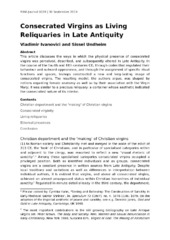| dc.contributor.author | Undheim, Sissel | |
| dc.contributor.author | Ivanovici, Vladimir | |
| dc.date.accessioned | 2020-05-18T09:28:33Z | |
| dc.date.available | 2020-05-18T09:28:33Z | |
| dc.date.issued | 2019-09-30 | |
| dc.Published | Undheim S, Ivanovici. Consecrated Virgins as Living Reliquaries in Late Antiquity. RIHA Journal. 2019(0228) | eng |
| dc.identifier.issn | 2190-3328 | |
| dc.identifier.uri | https://hdl.handle.net/1956/22295 | |
| dc.description.abstract | This article discusses the ways in which the physical presence of consecrated virgins was perceived, described, and subsequently altered in Late Antiquity. In the course of the fourth and fifth centuries CE, through codes that regulated their behaviour and outward appearance, and through the assignment of specific ritual functions and spaces, bishops constructed a new and long-lasting image of consecrated virgins. The resulting model, the authors argue, was shaped by notions regarding female anatomy as well as by their association with the Virgin Mary; it was similar to a precious reliquary: a container whose aesthetic indicated the consecrated nature of its interior. Published in RIHA Special Issue "From Living to Visual Images. Paradigms of Corporeal Iconicity in Late Antiquity", eds. Michele Bacci and Vladimir Ivanovici | en_US |
| dc.language.iso | eng | eng |
| dc.publisher | RIHA | eng |
| dc.rights | Attribution-NonCommercial-NoDerivs CC BY-NC-ND | eng |
| dc.rights.uri | https://creativecommons.org/licenses/by-nc-nd/4.0/ | eng |
| dc.title | Consecrated Virgins as Living Reliquaries in Late Antiquity | eng |
| dc.type | Peer reviewed | |
| dc.type | Journal article | |
| dc.date.updated | 2020-01-03T19:34:44Z | |
| dc.description.version | publishedVersion | |
| dc.rights.holder | Copyright © RIHA | eng |
| dc.identifier.cristin | 1740548 | |
| dc.source.journal | RIHA Journal | |

